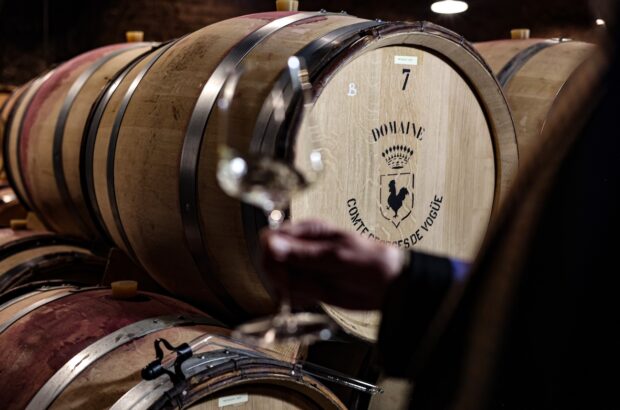Eighteen months ago, I was asked by two producers in the southern Rhône – Nicole Rolet of Domaine de la Verrière (which makes the Chêne Bleu brand) at Vaison-la-Romaine and Walter McKinlay of Domaine de Mourchon at Seguret – how the region’s wines could better be recognised and I agreed with the former that the key was the Grenache grape. Thus it transpired that in early June I co-chaired, with French wine critic Michel Bettane, an extraordinary three days devoted to what has been described as the unsung hero of the wine world.
Eighteen months ago, I was asked by two producers in the southern Rhône – Nicole Rolet of Domaine de la Verrière (which makes the Chêne Bleu brand) at Vaison-la-Romaine and Walter McKinlay of Domaine de Mourchon at Seguret – how the region’s wines could better be recognised and I agreed with the former that the key was the Grenache grape. Thus it transpired that in early June I co-chaired, with French wine critic Michel Bettane, an extraordinary three days devoted to what has been described as the unsung hero of the wine world.
More than 240 delegates from 23 countries attended an event packed with workshops, presentations and tastings of 300 wines. Up to that moment, Grenache never knew it had so many friends. Of the seven thinktanks that covered every aspect from growing to drinking, with the panels made up of international experts – Bettane and I dropped in and out of them all – it was remarkable how similar were the conclusions, how clearly each panel described the strengths and weaknesses of Grenache, and how focused they were on how to move forward. I’m sure had there been a Cabernet Sauvignon symposium, there would not have been such agreement or such a positive call to action to elevate the grape’s future from good to great, that will benefit producers, merchants and consumers alike.
Absent from global journalists were the French. Bettane expressed concern that the French media had turned its back on one of its greatest assets, quoting a noted communicator who had said that since the symposium was chaired by an Englishman and was held at an estate with American connections (Domaine de la Verrière), it would be unpatriotic to attend, particularly with Grenache from other countries being considered.
Presenting their report on the second day, the viticulture panel stressed that Grenache was currently the fourth most-planted red grape in the world, with 200,000ha (hectares), but down from 240,000ha in 1998, showing the need for preservation. Grenache’s advantages are that it is eco-friendly, long-lived (it has more old vines than any other variety), economical to farm, adapts to small production, and is the perfect grape for blending or for use on its own. As such, the panel said Grenache should be recognised as a ‘noble’ grape.
There were two winemaker panels, the first of which answered the question, ‘What is Grenache?’ It is friendly, diverse, rural, real, rich yet balanced, captivating but not perfect… it needs commitment, and is best made in smaller wineries. The second, chaired by Randall Grahm of California’s Bonny Doon Vineyards, discussed ‘Hands on Grenache’. They characterised the grape as a chameleon for its many colours, a supporting actor rather than a superstar, often seeming on the fringes of wine culture while actually being central to it. As featured in an interview in Decanter last month, Grahm described Old World Grenaches as vins de terroir and those from the New World as vins d’effort.
Two media panels followed, the first discussing the taste profile of Grenache: smooth, warm, ripe but not jammy, and spicy, with garrigue aromas of Provence. The conclusion was that since it could be white, rosé, red, sweet, fortified and even sparkling, it is a ‘one-stop’ grape variety. Likening it to a car, it is a 4×4, ready for any road; and to an actor, votes went for Gérard Depardieu and Clint Eastwood, while Pancho Campo MW, saying that his local Garnarcha was feminine, chose Penelope Cruz (‘the girl next door you should pay attention to’). The second panel, with input from Brazil, China, India, Israel and Hong Kong, discussed the appeal of Grenache in emerging markets, noting that it made perfect wines for the novice drinker, that food matching mattered little in these countries, and high alcohols even less.
Next up was the restaurant panel, who said that, due to its round fruit and low tannins, Grenache possesses inherent compatibility with food, that there is a Grenache for every part of a meal and because of its vast variety, it can be a wine for all seasons. They proposed a short primer entitled ‘Getting to know Grenache’, in which the serving temperature would be stressed at 15˚C–16˚C for the reds. Finally, the retail panel insisted, as many other panels did, that Grenache should be on the label, on the front if possible within appellation rules, on the back if not. Mark Savage MW said its strength was in providing both ‘workhorse and wonderhorse’ wines, thus appealing to all parts of the market.
Among the many proposals were the launch of a Global Grenache Association (Les Grenadiers du Grenache) and an International Grenache Day, already planned for 24 September. Also proposed was a series of tastings with Grenache-based wines against other more ‘noble’ red varieties, where the tasters would mark each wine based on the three Ps: pleasure, price and partnership (with food). My votes are already cast for the new hero of the wine world.
Written by Steven Spurrier






